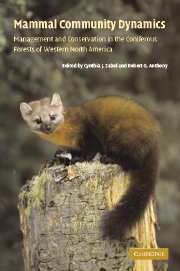 Mammal Community Dynamics
Mammal Community Dynamics Published online by Cambridge University Press: 15 December 2009
Introduction
Our approach
Here, we will present information about relationships between small mammals and an important food source, fruitbodies of (predominantly) ectomycorrhizal fungi. After providing some background on the function and diversity of the fungi involved, we will examine historical interest in mycophagy and current questions. The main focus will be on mycophagy (fungi consumption) and potential effects of disturbance on the interrelationships among trees, truffles, and mammals. We have not limited our discussion to western North America because much relevant research has occurred in Australia.
Mycorrhizae
Different plants form different types of mycorrhizae with different fungi. The Pinaceae are primarily ectomycorrhizal, the Cupressaceae primarily vesicular-arbuscular (VA) mycorrhizal, as are most herbaceous plants. Some genera or families, such as the Salicaceae, can regularly form both ecto- and VA mycorrhizae. The Ericales mostly have their own distinctive mycorrhizae, as do the orchids. The fungi that form these different mycorrhiza types have different dispersal strategies. Though general categories of mycorrhizae are usually defined in morphological terms with little regard to ecology (Smith and Read 1997) mycorrhizal associations can also be categorized ecologically – such as by the degree of dependence of tree species on mycorrhizae for growth and reproduction. This approach lends itself to inclusion of the spore dispersal mechanisms of the mycobiont in a broader ecological context (Trappe and Luoma 1992).
We will focus on ectomycorrhizal fungi (EMF) because those species seem to be the most important with regard to small mammal mycophagy.
To save this book to your Kindle, first ensure [email protected] is added to your Approved Personal Document E-mail List under your Personal Document Settings on the Manage Your Content and Devices page of your Amazon account. Then enter the ‘name’ part of your Kindle email address below. Find out more about saving to your Kindle.
Note you can select to save to either the @free.kindle.com or @kindle.com variations. ‘@free.kindle.com’ emails are free but can only be saved to your device when it is connected to wi-fi. ‘@kindle.com’ emails can be delivered even when you are not connected to wi-fi, but note that service fees apply.
Find out more about the Kindle Personal Document Service.
To save content items to your account, please confirm that you agree to abide by our usage policies. If this is the first time you use this feature, you will be asked to authorise Cambridge Core to connect with your account. Find out more about saving content to Dropbox.
To save content items to your account, please confirm that you agree to abide by our usage policies. If this is the first time you use this feature, you will be asked to authorise Cambridge Core to connect with your account. Find out more about saving content to Google Drive.